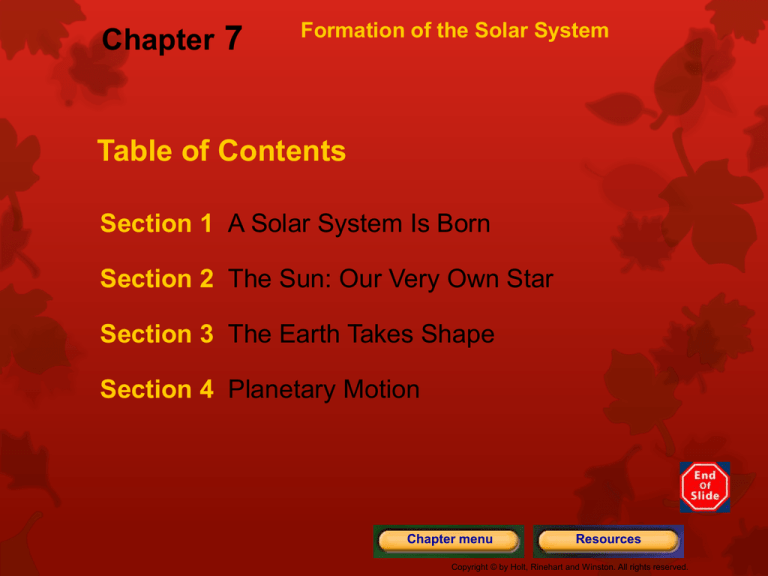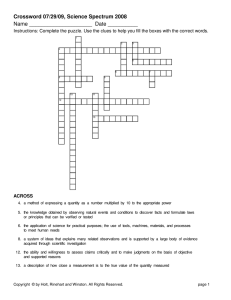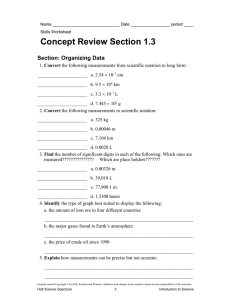
Chapter 7
Formation of the Solar System
Table of Contents
Section 1 A Solar System Is Born
Section 2 The Sun: Our Very Own Star
Section 3 The Earth Takes Shape
Section 4 Planetary Motion
Chapter menu
Resources
Copyright © by Holt, Rinehart and Winston. All rights reserved.
Chapter 7
Section 1 A Solar System Is Born
Objectives
• Explain the relationship between gravity and
pressure in a nebula.
• Describe how the solar system formed.
• Describe three types of small bodies in the solar
system.
Chapter menu
Resources
Copyright © by Holt, Rinehart and Winston. All rights reserved.
Chapter 7
Section 1 A Solar System Is Born
The Solar Nebula
• What Are Nebulas? Nebulas (or nebulae) are
mixtures of gases—mainly hydrogen and helium—
and dust made of elements such as carbon and
iron.
• Gravity Pulls Matter Together The matter of a
nebula is held together by the force of gravity.
Chapter menu
Resources
Copyright © by Holt, Rinehart and Winston. All rights reserved.
Chapter 7
Section 1 A Solar System Is Born
The Solar Nebula continued
• Pressure Pushes Matter Apart In a nebula,
outward pressure balances the inward gravitational
pull and keeps the cloud from collapsing.
Chapter menu
Resources
Copyright © by Holt, Rinehart and Winston. All rights reserved.
Chapter 7
Section 1 A Solar System Is Born
Upsetting the Balance
• Cosmic Collision The balance between gravity
and pressure in a nebula can be upset if two
nebulas collide or a nearby star explodes.
• What Is a Solar Nebula? The solar nebula—the
cloud of gas and dust that formed our solar
system—may have formed in this way.
Chapter menu
Resources
Copyright © by Holt, Rinehart and Winston. All rights reserved.
Chapter 7
Section 1 A Solar System Is Born
How the Solar System Formed
• From Planetesimals to Planets As bits of dust
circled the center of the solar nebula, some collided
and stuck together to form golf ball-sized bodies.
• These bodies eventually drifted into the solar
nebula, where further collisions caused them to
grow. The largest of these bodies are called
planetesimals, or small planets.
http://www.khanacademy.org/video/star-field-andnebula-images?playlist=Cosmology+and+Astronomy
Chapter menu
Resources
Copyright © by Holt, Rinehart and Winston. All rights reserved.
Chapter 7
Section 1 A Solar System Is Born
How the Solar System Formed, continued
• Gas Giant or Rocky Planet? The largest
planetesimals formed near the outside of the rotating
solar disk, where hydrogen and helium were
abundant. Therefore, the outside planets are gas
giants while the inner planets are rocky.
Chapter menu
Resources
Copyright © by Holt, Rinehart and Winston. All rights reserved.
Chapter 7
Section 1 A Solar System Is Born
How the Solar System Formed, continued
• The Birth of a Star As the planets were forming,
nearly all of the extra matter in the solar nebula was
traveling toward the center.
• The center of the solar nebula became so dense
and hot that hydrogen atoms began to fuse, or join
together, to form helium. At this point, the gas
stopped collapsing and our sun was born.
http://www.khanacademy.org/video/birth-ofstars?playlist=Cosmology+and+Astronomy
Chapter menu
Resources
Copyright © by Holt, Rinehart and Winston. All rights reserved.
Chapter 7
Section 1 A Solar System Is Born
How the Solar System Formed, continued
Chapter menu
Resources
Copyright © by Holt, Rinehart and Winston. All rights reserved.
Chapter 7
Section 1 A Solar System Is Born
How the Solar System Formed, continued
Chapter menu
Resources
Copyright © by Holt, Rinehart and Winston. All rights reserved.
Chapter 7
Section 1 A Solar System Is Born
Small Bodies in the Solar System
• Comets A comet is a
small body of ice, rock,
and cosmic dust loosely
packed together.
Comets have a solid
center, called a nucleus,
and often two tails—and
ion tail and a dust tail.
Chapter menu
Resources
Copyright © by Holt, Rinehart and Winston. All rights reserved.
Chapter 7
Section 1 A Solar System Is Born
Small Bodies in the Solar System,
continued
• Asteroids Small, rocky bodies that revolve around
the sin are called asteroids.
• Meteoroids Meteoroids are similar to but much
smaller than asteroids. A meteoroid is a small, rocky
body that orbits the sun.
Chapter menu
Resources
Copyright © by Holt, Rinehart and Winston. All rights reserved.
Chapter 7
Section 2 The Sun: Our Very Own
Star
Bellringer
Henry Thoreau once said, “The sun is but a
morning star.”
In your science log, explain what you think this
quotation means.
Chapter menu
Resources
Copyright © by Holt, Rinehart and Winston. All rights reserved.
Chapter 7
Section 2 The Sun: Our Very Own
Star
Objectives
• Describe the basic structure and composition of the
sun.
• Explain how the sun generates energy.
• Describe the surface activity of the sun, and identify
how this activity affects Earth.
Chapter menu
Resources
Copyright © by Holt, Rinehart and Winston. All rights reserved.
Chapter 7
Section 2 The Sun: Our Very Own
Star
The Structure of the Sun
• Surface of the Sun Although the sun may appear
to have a solid surface, it does not. The visible
surface of the sun starts at the point where the gas
becomes so thick that you cannot see through it.
Chapter menu
Resources
Copyright © by Holt, Rinehart and Winston. All rights reserved.
Chapter 7
Section 2 The Sun: Our Very Own
Star
Chapter menu
Resources
Copyright © by Holt, Rinehart and Winston. All rights reserved.
Chapter 7
Section 2 The Sun: Our Very Own
Star
Energy Production in the Sun
• Burning or Shrinking? It is clear to scientists that
the sun does not burn its fuel. In the past, scientists
thought that gravity caused the sun to slowly shrink,
thus releasing enough energy to heat the sun.
• Nuclear Fusion is the process by which two or
more low-mass nuclei join together, or fuse, to form a
more massive nucleus. During the process, energy is
produced. Nuclear fusion occurs in the sun.
Chapter menu
Resources
Copyright © by Holt, Rinehart and Winston. All rights reserved.
Chapter 7
Section 2 The Sun: Our Very Own
Star
Nuclear Fusion
http://youtu.be/Ee--KkyR7CU
Chapter menu
Resources
Copyright © by Holt, Rinehart and Winston. All rights reserved.
Chapter 7
Section 2 The Sun: Our Very Own
Star
Energy Production in the Sun, continued
• Fusion in the Sun In the center of the sun, the
temperature and pressure are very high. As a result,
the hydrogen nuclei have enough energy to
overcome the repulsive force, and hydrogen fuses
into helium.
Chapter menu
Resources
Copyright © by Holt, Rinehart and Winston. All rights reserved.
Chapter 7
Section 2 The Sun: Our Very Own
Star
Chapter menu
Resources
Copyright © by Holt, Rinehart and Winston. All rights reserved.
Chapter 7
Section 2 The Sun: Our Very Own
Star
Solar Activity
• Sunspots Sunspots are cooler, dark spots of the
photosphere of the sun, caused by the sun’s
magnetic fields slowing down the activity in the
convective zone.
Chapter menu
Resources
Copyright © by Holt, Rinehart and Winston. All rights reserved.
Chapter 7
Section 2 The Sun: Our Very Own
Star
Solar Activity, continued
• Climate Confusion Scientists have found that
sunspot activity can affect the Earth’s climate.
• Solar Flares The magnetic fields that cause
sunspots also cause solar flares. Solar flares are
regions of extremely high temperature and
brightness that develop on the sun’s surface.
Chapter menu
Resources
Copyright © by Holt, Rinehart and Winston. All rights reserved.
Chapter 7
Section 3 The Earth Takes Shape
Bellringer
The Earth is approximately 4.6 billion years old.
The first fossil evidence of life on Earth has been
dated to nearly 3.5 billion years ago.
Write a paragraph in your science journal
describing what Earth might have been like during
the first billion years of its existence.
Chapter menu
Resources
Copyright © by Holt, Rinehart and Winston. All rights reserved.
Chapter 7
Section 3 The Earth Takes Shape
Objectives
• Describe the formation of the solid Earth.
• Describe the structure of the Earth.
• Explain the development of Earth’s atmosphere
and the influence of early life on the atmosphere.
• Describe how the Earth’s oceans and continents
formed.
Chapter menu
Resources
Copyright © by Holt, Rinehart and Winston. All rights reserved.
Chapter 7
Section 3 The Earth Takes Shape
Formation of the Solid Earth
• The Effects of Gravity As the Earth grew to this
size, the rock at its center was crushed by gravity
and the planet started to become round.
• The Effects of Heat As the Earth was changing
shape, it was also heating up. The heat caused the
core of Earth to melt. Today, the Earth is still cooling
from the energy that was generated when it formed.
Chapter menu
Resources
Copyright © by Holt, Rinehart and Winston. All rights reserved.
Chapter 7
Section 3 The Earth Takes Shape
How the Earth’s Layers Formed
• Organized by Density As rocks melted on the
forming Earth, denser elements, such as nickel and
iron, sank to the center of the Earth and formed the
core. Less dense elements floated to the surface and
became the crust. This process is shown on the next
slide.
Chapter menu
Resources
Copyright © by Holt, Rinehart and Winston. All rights reserved.
Chapter 7
Section 3 The Earth Takes Shape
Chapter menu
Resources
Copyright © by Holt, Rinehart and Winston. All rights reserved.
Chapter 7
Section 3 The Earth Takes Shape
Formation of the Earth’s Atmosphere
• Earth’s Early Atmosphere Scientists think that
Earth’s early atmosphere was a mixture of gases that
were released as Earth cooled.
• Earth’s Changing Atmosphere As the Earth
cooled and its layers formed, the Earth’s atmosphere
changed. This atmosphere probably formed from
volcanic gases.
Chapter menu
Resources
Copyright © by Holt, Rinehart and Winston. All rights reserved.
Chapter 7
Section 3 The Earth Takes Shape
Formation of the Earth’s Atmosphere
http://www.khanacademy.org/video/earthformation?playlist=Cosmology+and+Astronomy
Chapter menu
Resources
Copyright © by Holt, Rinehart and Winston. All rights reserved.
Chapter 7
Section 3 The Earth Takes Shape
The Role of Life
• Ultraviolet Radiation Scientists think that
ultraviolet (UV) radiation, the same radiation that
causes sunburns, helped produce the conditions
necessary for life.
• The Source of Oxygen Photosynthetic organisms
played a major role in changing Earth’s atmosphere
to become the mixture of gases, including oxygen,
that you breathe today.
Chapter menu
Resources
Copyright © by Holt, Rinehart and Winston. All rights reserved.
Chapter 7
Section 3 The Earth Takes Shape
Formation of Oceans and Continents
• Oceans From Rainfall Scientists think that the
oceans probably formed during Earth’s second
atmosphere, when the Earth was cool enough for
rain to fall and remain on the surface.
• The Growth of Continents The continents over
time thickened and slowly rose above the surface of
the ocean.
Chapter menu
Resources
Copyright © by Holt, Rinehart and Winston. All rights reserved.
Chapter 7
Section 4 Planetary Motion
Bellringer
Create a mnemonic device to help you remember
the difference between rotation and revolution.
Chapter menu
Resources
Copyright © by Holt, Rinehart and Winston. All rights reserved.
Chapter 7
Section 4 Planetary Motion
Objectives
• Explain the difference between rotation and
revolution.
• Describe three laws of planetary motion.
• Describe how distance and mass affect
gravitational attraction.
Chapter menu
Resources
Copyright © by Holt, Rinehart and Winston. All rights reserved.
Chapter 7
Section 4 Planetary Motion
A Revolution in Astronomy
• Each planet spins on its axis. The spinning of a
body, such as a planet, on its axis is called rotation.
• The path that a body follows as it travels around
another body in space is called the orbit. One
complete trip along an orbit is called a revolution.
Chapter menu
Resources
Copyright © by Holt, Rinehart and Winston. All rights reserved.
Chapter 7
Section 4 Planetary Motion
Chapter menu
Resources
Copyright © by Holt, Rinehart and Winston. All rights reserved.
Chapter 7
Section 4 Planetary Motion
A Revolution in Astronomy, continued
• Kepler’s First Law of Motion The planets move
around the sun in an ellipse.
• Kepler’s Second Law of Motion The planets
seemed to move faster when they are close to the
sun and slower when they are farther away.
• Kepler’s Third Law of Motion Planets further
from the sun take longer to orbit the sun.
Chapter menu
Resources
Copyright © by Holt, Rinehart and Winston. All rights reserved.
Chapter 7
Section 4 Planetary Motion
Chapter menu
Resources
Copyright © by Holt, Rinehart and Winston. All rights reserved.
Chapter 7
Section 4 Planetary Motion
Newton to the Rescue!
• The Law of Universal Gravitation Newton’s law
of universal gravitation states that the force of gravity
depends on the product of the masses of the objects
divided by the square of the distance between the
objects.
• Orbits Falling Down and Around Gravity keeps
the moon from flying off in a straight path. This
principle holds true for all bodies in our solar system.
Chapter menu
Resources
Copyright © by Holt, Rinehart and Winston. All rights reserved.
Chapter 7
Section 4 Planetary Motion
Chapter menu
Resources
Copyright © by Holt, Rinehart and Winston. All rights reserved.
http://youtu.be/haAhdtDmsOw
Chapter menu
Resources
Copyright © by Holt, Rinehart and Winston. All rights reserved.
Chapter 7
Formation of the Solar System
Concept Map
Use the terms below to complete the concept map
on the next slide.
natural resources
water
renewable resources
petroleum
nonrenewable resources
recycling
trees
Chapter menu
Resources
Copyright © by Holt, Rinehart and Winston. All rights reserved.
Chapter 7
Formation of the Solar System
Chapter menu
Resources
Copyright © by Holt, Rinehart and Winston. All rights reserved.
Chapter 7
Formation of the Solar System
Chapter menu
Resources
Copyright © by Holt, Rinehart and Winston. All rights reserved.
End of Chapter 7 Show
Chapter menu
Resources
Copyright © by Holt, Rinehart and Winston. All rights reserved.




